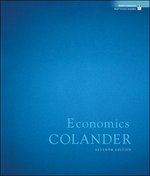Question
Question One a)A risk-averse individual is offered a choice between a gamble that pays1000 with a probability of 25% and 100 with a probability of
Question One a)A risk-averse individual is offered a choice between a gamble that pays1000 with a probability of 25% and 100 with a probability of 75%, or a payment of 325. Which would he choose? What if the payment was 320? b)Draw a utility function that exhibits risk-loving behavior for small gambles and risk averse behavior for larger gambles. c)Why might a neighborhood group have a harder time selfinsuring forflood damage versus fire damage? d)True or false? Convenience stores near the campus have high pricesbecause they have to pay high rents. e)True or false? In long-run industry equilibrium no firm will be losingmoney Question Two a)What is a game in normal form?What is a strictly dominated strategy in a normal-form game? What is a pure-strategy Nash equilibrium in a normal-form game? b)In the following normal-form game, what strategies survive iterated elimination of strictly dominated strategies?What are pure-strategy Nash equilibria? LCR T2,01,14,2 M3,41,22,3 B1,30,23,0 c)Consider a two-period model with two firms, Aand B. In the first period, they simultaneously chooseone of two actions, Enter or Don't enter. Entry requiresthe expenditure of a fixed entry cost of 10. In thesecond period, whichever firms enter play a pricinggame as follows. If no firm enters, the pricing game istrivial, and profits are zero. If only one firm enters, itearns the monopoly profit of 30. If both firms enter,they engage in competition as in the Bertrand modelwith homogeneous products.i)Using backward induction, fold the gameback to the first period in which firms maketheir choice of Enter or Don't enter. Writedown the normal form (a 2 by 2 matrix) forthis game. ii)Solve for the mixed-strategy Nash equilibriumof this game. iii)Compare the results from the mixedstrategyNash equilibrium to the Bertrand Paradox.? Question Three a)When prices are (1,2)=(2,1)a consumer demands (1,2)=(1,2),and when prices are (1,2)=(1,2)the consumer demands (1,2)=(2,1).Is this behavior consistent with the model of maximizing behavior? b)Suppose a consumer has preferences between two goods that are perfectsubstitutes. Can you change prices in such a way that the entire demandresponse is due to the income effect? c)Suppose that preferences are concave. Is it still the case that the substitution effect is negative? d)Suppose that the consumer has a demand function for milk of the form 1=50+ 501 Originally his income is 600 per week and the price of milk is 15per quart.Now suppose that the price of milk falls to 10per quart. Calculate (i)Substitution effect (ii)Income effect (iii)Total change Question Four a)Suppose a market has two airlines, Kalingalinga Airways and Kanyama Airline. The estimated airline market demand function is linear, =339 where price, , is the kwachacost of a one-way flight, and the total quantity of the two airlines combined, , is measured in thousands of passengers flying one way per quarter.Each airline has a constant marginal cost, , and an average cost,, of 147 per passenger per flight. i)How does the monopoly outcome compare to duopoly (Cournot with two firms)?ii)Suppose that one of the firms Kalingalinga airways isaleader and set its output before its rival, the follower, Kanyama airline.Find the equilibrium quantity, price and profit under this arrangement. b)Because many consumers view Coke and Pepsi as imperfect substitutes, the demand for each good depends on both firms' prices. Gasmi, Laffont, andVuong (1992) estimated the Coke demand function as =584+2 where is the quantity of Coke demanded in tens of millions of cases (a case is 24 twelveounce cans) per quarter, is the price of 10 cases of Coke, and is the price of 10 cases of Pepsi. Find the Nash-Bertrand equilibrium. Question Five Suppose we are given the Cobb-Douglas production function (1,2 )=1 1 32 2 3 , where 1and 2are two goods. Denote 1and 2as the prices of those two goods and let be per period money income. Derive each of the following: a)The Marshallian demand functions. b)The Hicksian demand function c)The indirect utility function. d)The expenditure function. e)Draw a diagram of the solution. There should be two graphs, one above the other; the first containing the indifference curves and budget constraint that characterise the solution to the consumer's choice problem; the second characterising the demand functions.
Step by Step Solution
There are 3 Steps involved in it
Step: 1

Get Instant Access to Expert-Tailored Solutions
See step-by-step solutions with expert insights and AI powered tools for academic success
Step: 2

Step: 3

Ace Your Homework with AI
Get the answers you need in no time with our AI-driven, step-by-step assistance
Get Started


